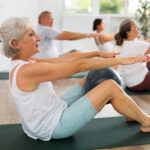Midlife action step: How exercise can turn back the clock on inactivity
 (NaturalHealth365) In our increasingly sedentary world, where automation and digital entertainment often keep many of us glued to screens, the importance of physical activity cannot be overstated. Modern science confirms that a lack of physical activity can indeed lead to significant health problems. The good news is that it’s never too late to start.
(NaturalHealth365) In our increasingly sedentary world, where automation and digital entertainment often keep many of us glued to screens, the importance of physical activity cannot be overstated. Modern science confirms that a lack of physical activity can indeed lead to significant health problems. The good news is that it’s never too late to start.
Research published in PLOS Medicine offers encouraging news for those who may have been less active in their younger years. The study analyzed data collected at 3-year intervals from 1998 to 2019, involving 11,336 participants from the Australian Longitudinal Study on Women’s Health (ALSWH). These participants were from the 1946 to 1951 birth cohort.
The surprising key to turning back your body’s clock
Recent research has uncovered a powerful way to potentially reverse years of inactivity and improve health outcomes in midlife. The findings from this extensive study offer hope and actionable insights for those looking to enhance their physical well-being, regardless of their past exercise habits. Here are the key takeaways:
- 150 minutes of moderate physical activity per week appears to be an optimal target for middle-aged adults.
- Women who met this target over a 15-year period showed better physical health than those who didn’t.
- Even those who were previously inactive saw substantial benefits when they began exercising regularly in midlife.
- The health outcomes for those who started exercising in their 50s were nearly on par with those who had been consistently active earlier in life.
It’s worth noting that while this study focused on women, other research has shown similar benefits for men. For example, even the World Health Organization recommends 150-300 minutes of moderate-intensity aerobic physical activity per week for adults.
The importance of midlife exercise
The study suggests that exercise “accumulates” during midlife, contributing to better health outcomes in later years. This aligns with other research indicating that maintaining physical activity throughout adulthood can help preserve muscle mass, bone density, and cognitive function as we age.
Even small increases in physical activity can have measurable benefits. The study found that each point increase in physical activity was associated with decreased mortality risk. This is particularly encouraging for those who may find it challenging to meet the full 150-minute weekly target immediately.
The role of sedentary behavior
While increasing physical activity is crucial, it’s equally important to address sedentary behavior. Research published in reputable journals has consistently shown that prolonged sitting can have detrimental health effects, even for those who meet recommended exercise guidelines.
To combat this, experts recommend breaking up sitting time with short bouts of activity. Simple strategies like standing up regularly, taking short walks during breaks, or using a standing desk can help mitigate the negative impacts of prolonged sitting. These small changes, combined with regular exercise, can contribute to improved overall health outcomes.
Start your journey to better health
If you’re in your 40s, 50s, or beyond and haven’t been regularly active, it’s not too late to start. Here are some tips:
- Start slowly: Begin with short walks or gentle exercises and gradually increase intensity and duration.
- Find activities you enjoy: This could be walking, swimming, cycling, dancing, or any form of movement that you find pleasurable.
- Make it social: Exercising with friends or joining group activities can increase motivation and enjoyment.
- Be consistent: Regular, moderate activity is more beneficial than occasional intense workouts.
- Consult your doctor: If you have any health concerns, it’s always wise to check with a healthcare professional before starting a new exercise routine.
While the PLOS Medicine study provides valuable insights, it’s important to note that it relied on self-reported data, which can sometimes be less accurate than objective measurements. However, its findings are consistent with a broad body of research supporting the benefits of physical activity at all stages of life.
Remember, the goal is to move more and sit less. Any increase in physical activity can contribute to better health outcomes, regardless of your starting point. It’s never too late to invest in your health through regular physical activity.
Sources for this article include:



